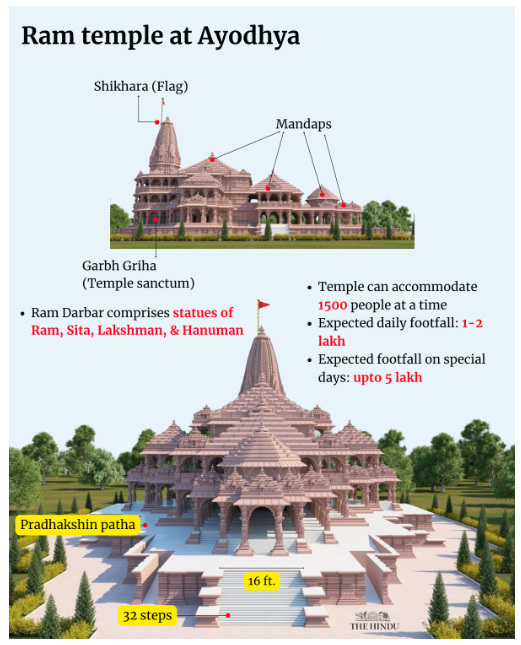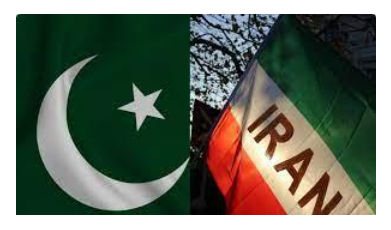Thursday, 25th January 2024
Winter Storms in the US
In News: Winter storms across the United States have presented a variety of challenges, impacting different states with below-freezing temperatures, snowfall, and icy conditions.
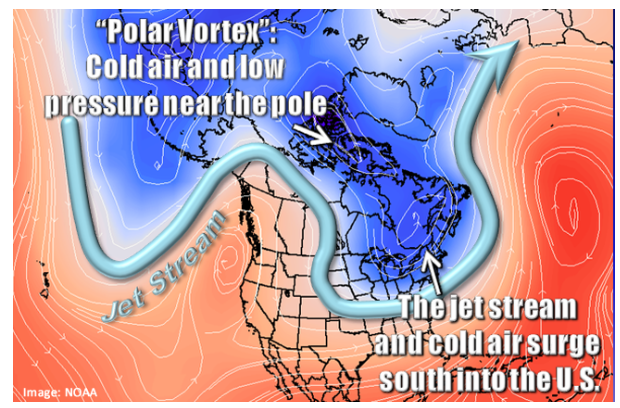
Factors Contributing to Severe Winter Storms in the US
- Polar Vortex
- The Polar Vortex, a massive low-pressure system with cold air around the Earth's poles, maintains a counterclockwise airflow to retain colder air near the Poles.
- During disruptions, cold air can move southward into the US, causing frigid temperatures.
- Arctic amplification, linked to climate change, accelerates warming in the Arctic, weakening the polar vortex and making it susceptible to disruptions.
- Weakening can result in the stretching or splitting of the polar vortex, allowing cold Arctic air to spill southward.
- Arctic Air Masses
- Intrusion of Arctic air masses originating in the Arctic region can lead to a rapid drop in temperatures in the US.
- Jet Stream Patterns
- The jet stream, a high-altitude fast-flowing air ribbon, steers weather systems.
- Changes in jet stream patterns can facilitate the southward movement of cold Arctic air, affecting large areas of the US.
Understanding Winter Storms
- About Winter Storms
- Weather events characterized by extreme cold temperatures, precipitation in the form of snow, sleet, or freezing rain, often accompanied by strong winds.
- Disrupt normal daily activities, impact transportation, and pose various hazards.
- Winter Storm Formation
- Moist Air Rising
- Begins with moist air rising into the atmosphere, often at a cold front or as air ascends a hill or mountain.
- Source of Moisture
- Moisture is essential for cloud formation and precipitation, typically provided by air blowing across large bodies of water.
- Cold Air
- Presence of cold air is crucial, with temperatures below freezing both near the ground and throughout atmospheric layers.
- Moist Air Rising
- Types of Winter Storms
- Snowstorms
- Precipitation falls mainly as snow, dependent on air temperature.
- Blizzards
- Characterized by strong winds (≥35 MPH), causing blowing snow and reduced visibility.
- Lake Effect Storms
- Form due to moisture from the Great Lakes, leading to heavy snowstorms in specific regions.
- Ice Storms
- Winter storms with an accumulation of at least 0.25 inches of ice, resulting in hazardous conditions on surfaces, branches, and powerlines.
- Snowstorms
|
UPSC Previous Year Questions Prelims (2011) Q. The formation of ozone hole in the Antarctic region has been a cause of concern. What could be the reason for the formation of this hole? (a) Presence of prominent tropospheric turbulence; and inflow of chlorofluorocarbons (b) Presence of prominent polar front and stratospheric clouds; and inflow of chlorofluorocarbons (c) Absence of polar front and stratospheric clouds; and inflow of methane and chlorofluorocarbons (d) Increased temperature at polar region due to global warming Ans: (b)
Mains (2017) Q.1 How does the cryosphere affect global climate? Mains (2021) Q.2 How do the melting of the Arctic ice and glaciers of the Antarctic differently affect the weather patterns and human activities on the Earth? Explain. Mains (2018) Q.3 Why is India taking keen interest in resources of Arctic region? |
Source: TH
Maldives rules out Research by Chinese Vessel in its Waters
In News: The Maldives Foreign Ministry has categorically stated that the Chinese research vessel Xiang Yang Hong 03 will not be conducting any research activities within Maldivian waters
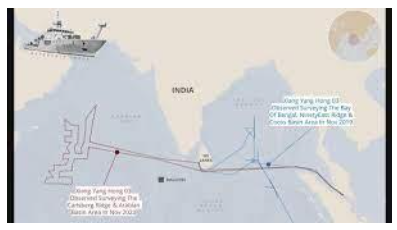
Chinese Research Vessel in the Maldives: Diplomatic Requests and Concerns
- Diplomatic Request by China
- The Maldives Foreign Ministry confirms a diplomatic request from the Chinese government for necessary clearances.
- Purpose includes a port call, personnel rotation, and replenishment for the Chinese research vessel Xiang Yang Hong 03.
- Notable Context in South Asia
- Attention in India intensifies as reports of the Chinese vessel heading to the Maldives surface.
- Sri Lanka's one-year moratorium on foreign research vessels, influenced by Indian concerns over Chinese vessel visits.
- Chinese Vessel Xiang Yang Hong 03
- The vessel is expected to arrive in Malé on February 8 after exploring the southern Indian Ocean from January to May 2024.
- Previous calls at Sri Lankan ports, with no clearance for a visit earlier this year.
Tensions in India-Maldives Relations
- Maldivian President Mohamed Muizzu demands the withdrawal of Indian troops from the Maldives.
- Non-renewal of joint hydrographic survey exercise with India.
- Pledges to elevate strategic ties with China during a state visit, marked by multiple agreements and a $130 million aid package.
Indian Concerns and Objections
- Maldives grants permission for Chinese research vessels despite objections from India.
- India expresses concerns to both Sri Lanka and the Maldives over the docking of the Xiang Yang Hong 03.
- Chinese Naval Expansion in the Indian Ocean
- Indian Navy briefs the Parliamentary Standing Committee on Defence in April 2023.
- China's naval fleet grows from 250 to over 350 ships in a decade, establishing it as the world's largest navy.
- Concerns raised about the dual nature of data collected by Chinese research activities in international waters, with both civilian and military applications.
Source: TH
National Monetisation Pipeline
In News: The Central government has recently opted to initiate an Asset Recycling Drive as part of the National Monetization Pipeline (NMP), with the objective of creating funds for fresh investments in infrastructure projects.
Understanding the National Monetisation Pipeline (NMP)
- Overview of NMP
- The NMP aims to generate Rs 6-lakh crore by leasing core assets of the Central government over FY 2022-25.
- Sectors involved include roads, railways, power, oil and gas pipelines, telecom, and civil aviation.
- Focus on core assets of central government line ministries and CPSEs in infrastructure sectors.
- Expansion of Scope
- Coordination underway to include assets from states at both central and state levels.
- Non-core asset monetization transferred from DIPAM to DPE for efficiency.
- Aligns with the National Infrastructure Pipeline (NIP) to support Rs 111 trillion investments in six years through FY25.
- Need for NMP
- Addresses challenges such as cost overruns, overcapitalization, resource optimization, coordination issues, and labor reforms.
- Aims to optimize resources by introducing private sector efficiency and market-driven approaches.
- Significance of NMP
- Aligned with PM Gati Shakti for integrated infrastructure development.
- Boosts the economy, generates employment, and supports competitiveness.
- Utilizes underutilized public assets to fund new projects and infrastructure augmentation.
- Achievements and Expectations
- Mining sector leads monetization in 2023-24, surpassing targets significantly.
- NHAI contributes significantly through Toll Operate Transfer (ToT), securitization, and Infrastructure Investment Trust (InvIT) models.
- Expectations for power, railways, and oil and gas sectors in FY24.
Challenges Associated with NMP
- Taxpayers’ Concerns
- Concerns about double charges on public assets post-monetization.
- Balancing public investment and private involvement to address taxpayer apprehensions.
- Cycle of Asset Creation and Monetization
- Potential for a cycle of creating and monetizing assets as they become liabilities.
- Ensuring a strategic approach to prevent asset management challenges.
- Asset-Specific Challenges
- Challenges in capacity utilization, regulated tariffs, and investor interest in specific sectors.
- Addressing issues related to gas and petroleum pipelines, power sector assets, and national highways.
- Monopolization Concerns
- Critique on potential monopolization and reduced competition.
- Balancing asset transfer without compromising market dynamics and end-user costs.
Way Forward for NMP
- Enhance transparency in the monetization process for stakeholder trust.
- Communicate benefits in terms of economic growth, job creation, and improved infrastructure.
- Continuously refine policy framework to address emerging challenges.
- Establish a supportive regulatory environment and a robust monitoring system for project performance.
|
UPSC Previous Year Questions Mains (2017) Q1. Account for the failure of manufacturing sector in achieving the goal of labour-intensive exports. Suggest measures for more labour-intensive rather than capital-intensive exports. Mains (2015) Q.2 The nature of economic growth in India in recent times is often described as a jobless growth. Do you agree with this view? Give arguments in favour of your answer. |
Source: FE
Wild Life Licensing Rules 2024
In News: The central government has recently amended the wildlife trade rules through the introduction of the Wild Life (Protection) Licensing (Additional Matters for Consideration) Rules, 2024.
Understanding the Wildlife Licensing Rules 2024
- Changes in Schedule I
- In the new rules, consultation with the central government is required for licensing related to any wild animal specified in Schedule I to the Wildlife Protection Act, 1972.
- Schedule I includes species like tigers, elephants, rhinos, emphasizing their need for utmost protection.
- Modification in Schedule II
- Notable change: The new guidelines remove licensing restrictions for species listed in Schedule II of the Wildlife Protection Act, 1972.
- Licences for trading in Schedule II species can now be granted without consultation or approval from the central government.
- Factors Considered in Licensing
- The new rules outline specific factors for authorized officers to consider when granting licences.
- Factors include the applicant's capacity, source and manner of obtaining supplies, existing licences in the area, and implications on hunting or trade.
Concerns Regarding the New Rules
- Exclusion of Schedule II Species
- Lack of clarity on why licensing restrictions for Schedule II species have been removed.
- Schedule II includes important species like endangered mammals, birds, turtles, geckos, and snakes.
- Concerns arise about the level of protection these species will receive.
- Rationalization of Schedules in 2022
- Schedules of the Wildlife Protection Act, 1972, were rationalized in The Wild Life (Protection) Amendment Act, 2022.
- Questions raised on the alignment of the exclusion of certain Schedule II species with the rationalization process.
- Experts inquire whether these species have indeed increased in numbers, justifying a lower level of protection.
Overview of Wildlife (Protection) Act, 1972
- Purpose and Framework
- Legal framework for the protection of wild animals, plants, and their habitats.
- Regulates trade in wildlife products and lists schedules categorizing species for varying degrees of protection.
- Latest Amendment (Wildlife (Protection) Amendment Act, 2022)
- Reduction of schedules from six to four.
- Schedule I for the highest level of protection, Schedule II for lesser protection, Schedule III for protected plant species, and Schedule IV for CITES-listed specimens.
Way Forward for Wildlife Protection
- Transparent Consultation Mechanism
- Establishing a robust and transparent mechanism for the consultation and approval process for Schedule I species.
- Ensuring participation and representation of relevant stakeholders.
- Explanation for Schedule II Exclusion
- Providing a clear and rational explanation for the exclusion of Schedule II species from the consultation and approval process.
- Clarifying the criteria for selecting these species.
- Strengthening Enforcement
- Strengthening the enforcement and compliance of wildlife trade laws and regulations.
- Enhancing penalties and incentives for both violators and law-abiding individuals.
|
UPSC Previous Year Questions Prelims (2016) Q. If a particular plant species is placed under Schedule VI of the Wildlife Protection Act, 1972, what is the implication? (2020) (a) A licence is required to cultivate that plant. Ans: (a) Mains (2018) Q. How does biodiversity vary in India? How is the Biological Diversity Act, 2002 helpful in the conservation of flora and fauna? |
Source: DTE
World's Largest Deep Sea Coral Reef
In News: Researchers have charted the most extensive deep-sea coral reef ever identified, situated along the Atlantic coastline of the United States.

Features of the Recently Discovered Reef
- Impressive Size
- The newly found reef extends approximately 500 km from Florida to South Carolina.
- It boasts a width of up to 110 km at certain points, showcasing its expansive dimensions.
- Comparative Size
- The reef's area is nearly three times larger than the renowned Yellowstone National Park.
- Depth and Location
- Discovered at varying depths ranging from 200 to 1,000 meters.
- Positioned in areas beyond the reach of sunlight, adding to its mysterious and less-explored nature.
- Contrast with the Great Barrier Reef
- Distinguishing itself from the recently found largest coral reef in deep water, the Great Barrier Reef remains the largest coral reef system, but in shallow waters.
- Potential for Future Discoveries
- A scientist notes the potential discovery of even larger deep-sea reefs in the future.
- Emphasizes that only around 25% of the world's ocean floor has been thoroughly mapped in high resolution, indicating unexplored possibilities.
|
UPSC Previous Year Questions Prelims (2018) Q. Consider the following statements:
Which of the statements given above is/are correct? (a) 1 and 2 only Ans: (d) Mains (2019) Q. Assess the impact of global warming on the coral life system with examples. |
Source: DH
MoE Guidelines for Coaching Centres
In News: The Ministry of Education has released guidelines for coaching centers, explicitly restricting the admission of students below the age of 16.
Key Guidelines for Coaching Centres:
- Age Restrictions
- Enrolment restricted to students aged 16 and above.
- Admission permitted only after completion of secondary school examination.
- Tutor Qualification
- Tutors required to possess a minimum graduation qualification.
- Hiring individuals convicted of moral turpitude prohibited.
- Avoiding False Promises
- Prohibition on making misleading promises, guaranteeing ranks, or assuring good marks.
- Strict prohibition on misleading advertisements regarding coaching quality, facilities, or results.
- Updated Website
- Mandatory requirement for coaching centers to maintain a website with current information on tutor qualifications, courses, duration, hostel facilities, and fees.
- Mental Well-being
- Emphasis on prioritizing mental well-being.
- Requirement to establish a counseling system, provide information about psychologists and counselors, and train tutors in mental health issues.
- Fee Regulations
- Stipulation for fair and reasonable tuition fees.
- Provision for pro-rata refunds if a student leaves a course prematurely.
- Inclusive Policies
- Prohibition of discrimination based on religion, race, caste, sex, place of birth, or descent.
- Encouragement for special efforts to increase the representation of female students, those with disabilities, and marginalized groups.
- Infrastructure Standards
- Mandate for a minimum of one square meter per student during a class.
- Requirement for coaching center buildings to comply with fire safety codes, building safety codes, and other relevant standards.
- Emphasis on buildings and surroundings being Divyang-friendly as per the Rights of Persons with Disabilities Act, 2016.
- Government Oversight
- Proposal for the registration of new and existing coaching centers within three months of the guidelines taking effect.
- Delegation to state governments for monitoring coaching center activities and ensuring compliance with registration eligibility.
- Penalties
- Penalties for violations:
- Rs 25,000/- for the first offense.
- Rs. 1,00,000/- for the second offense.
- Revocation of registration for subsequent offenses.
Source: TH
LED lamps
In News: The Royal Swedish Academy of Sciences has declared that, whereas incandescent light bulbs illuminated the 20th century, LED lamps would be the illumination source for the 21st century.
Understanding Diodes:
- Physical Characteristics
- An electronic component, typically around 5 mm wide.
- Features two terminals known as the anode and cathode.
- Primary Function
- Serves to allow current flow in only one direction.
- Utilizes a P-N Junction Diode to achieve this.
- P-N Junction
- The junction occurs at the interface of p-type and n-type semiconductors.
- The p-side (positive) has an abundance of holes, while the n-side (negative) contains excess electrons.
- Electron and Hole Concept
- Electrons are subatomic particles with a negative charge.
- "Holes" in a PN junction refer to the absence of an electron in the valence band, created when an electron moves to a higher energy level.
- Band Gap
- The band gap represents the energy difference between the highest occupied and lowest unoccupied electronic states in a material.
Understanding Light Emitting Diodes (LED):
- Semiconductor Nature
- LEDs are semiconductors capable of emitting light with the passage of an electric current.
- P-N Junction Operation
- Within the diode's p-n junction, electrons possess more energy than holes.
- When an electron occupies a hole, it releases energy, leading to light emission.
- Nobel Prize Recognition (2014)
- The Nobel Prize in Physics in 2014 was awarded to Isamu Akasaki, Hiroshi Amano, and Shuji Nakamura.
- Acknowledged for inventing efficient blue light-emitting diodes, a breakthrough enabling the development of bright and energy-efficient white light sources.
- Historical Limitation
- While red and green diodes existed, the lack of blue light hindered the creation of white lamps until the breakthrough achievements of Akasaki, Amano, and Nakamura.
|
UPSC Previous Year Questions Prelims (2021) Q. With reference to street lighting, how do sodium lamps differ from LED lamps?
Select the correct answer using the code given below. (a) 3 only Ans: (c) Mains (2021) Q. The Nobel Prize in Physics of 2014 was jointly awarded to Akasaki, Amano and Nakamura for the invention of Blue LEDs in the 1990s. How has this invention impacted the everyday life of human beings? |
Source: TH
Mpemba Effect
In News: Scientists remain captivated by the Mpemba effect due to its intricate interplay of physical mechanisms.
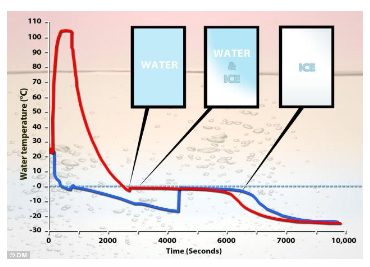
Understanding the Mpemba Effect:
- Origin and Naming
- Named after Tanzanian student Erasto Mpemba, who highlighted this counterintuitive phenomenon in 1969.
- Counterintuitive Observation
- Involves the peculiar observation that hot water can freeze faster than cold water under similar conditions.
- Historical Noticing
- While Aristotle, Francis Bacon, and René Descartes had observed this effect centuries earlier, it gained scientific attention more recently.
- Various Experiments Conducted
- Researchers have undertaken numerous experiments to comprehend the causes of the Mpemba effect.
- However, a consensus conclusion has not been reached.
- Microbubbles Hypothesis
- One posited cause is the presence of microbubbles suspended in water heated by boiling.
- These cavities may enhance convection and accelerate heat transfer as the water cools.
- Evaporation Contribution
- Warmer water evaporates more, and this evaporation process is inherently endothermic (similar to how sweat cools the skin).
- Enhanced convection and accelerated heat transfer occur in warmer water due to its lower density.
- Frost as an Insulator
- Another factor considered is the presence of frost in cold water.
- Frost acts as an insulator, potentially slowing the loss of heat during the cooling process.
- Compounds in Water Hypothesis
- Scientists explore the possibility of compounds like calcium carbonate precipitating and dissolving in water during boiling.
- This process might alter the freezing point of the water.
- Ongoing Scientific Inquiry
- Despite various hypotheses, ongoing scientific inquiry continues to unravel the complexities of the Mpemba effect.
Source: TH
The Agulhas Long-billed Lark
In News: The Agulhas Long-billed Lark is showcasing adaptability and resilience, persisting even as farming encroaches upon its nesting grounds in South Africa.
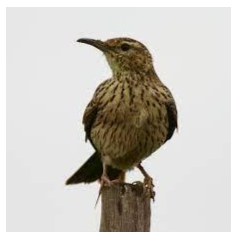
Understanding the Agulhas Long-billed Lark:
- Physical Characteristics
- A small passerine bird with a generally inconspicuous appearance.
- Nesting Habits
- Constructs nests on the ground, predominantly in Renosterveld fynbos—a vegetation type rich in grasses and wild spring flowers.
- Endemic to South Africa
- An endemic species found exclusively in South Africa.
- Specifically restricted to the Agulhas plains.
- Identification Challenge
- Typically categorized as "little brown birds," often posing identification challenges due to their subtle features.
- Preference for Renosterveld
- Shows a distinct preference for nesting in Renosterveld, highlighting its ecological adaptation.
- Habitat Adaptation
- Appears to adapt well to modified habitats such as farmlands.
- The distribution, however, remains patchy, and the reasons for this pattern are not fully understood.
- Habitat Range
- Primarily concentrated in the Agulhas arable farmlands, spanning from east of the Hottentots-Holland mountain range to Mossel Bay.
- Conservation Status
- IUCN classifies it as "Near Threatened," signifying potential vulnerability.
- Threats to Survival
- Land use changes and unforeseen events could pose significant threats to the species.
- The potential impact extends to other species dependent on the same vegetation, emphasizing the interconnectedness of ecosystems.
Source: DTE
Design-Linked Incentive scheme
In News: Since its announcement, the Design-Linked Incentive scheme (DLI) has approved only seven startups, significantly falling short of its target to support 100 startups over a span of five years.
Understanding the Design-Linked Incentive Scheme:
- Scheme Overview
- The Design-Linked Incentive scheme aims to provide financial incentives and design infrastructure support for the development and deployment of semiconductor designs, including Integrated Circuits (ICs), Chipsets, System on Chips (SoCs), Systems & IP Cores, and related designs.
- Objectives
- Foster growth among domestic companies, startups, and MSMEs in the semiconductor domain.
- Achieve substantial indigenization of semiconductor content and IPs in electronic products used within the country, promoting import substitution and value addition in the electronics sector.
- Strengthen access to semiconductor design infrastructure for startups and MSMEs.
- Duration
- The scheme is initially set for a period of three (3) years, starting from January 1, 2022.
- Components of the Scheme
- Chip Design Infrastructure Support
- C-DAC (Centre for Development of Advanced Computing) will establish the India Chip Centre.
- The center will host state-of-the-art design infrastructure, including EDA Tools, IP Cores, and support for MPW (Multi Project Wafer fabrication) & post-silicon validation.
- Access to this infrastructure will be facilitated for supported companies.
- Chip Design Infrastructure Support
- Product Design Linked Incentive
- Offers reimbursement of up to 50% of eligible expenditure, capped at ₹15 Crore per application.
- Fiscal support for approved applicants engaged in semiconductor design.
- Deployment Linked Incentive
- Provides an incentive ranging from 6% to 4% of net sales turnover over 5 years.
- Ceiling set at ₹30 Crore per application for approved applicants deploying semiconductor designs in electronic products.
- Nodal Agency
- The Centre for Development of Advanced Computing (C-DAC) serves as the nodal agency for implementing the scheme.
Source: TH
One Nation One Election
In News: A recent article delves into the disadvantages of the concept of concurrent elections for both the Lok Sabha and State Legislative Assemblies, commonly known as "One Nation One Election."

Central Idea of One Nation-One Election (ONOE)
- Concept Overview
- Proposes simultaneous Lok Sabha and State elections once every five years.
- Aims to streamline electoral processes, saving time and resources.
- Historical Context
- First suggested by Election Commission in 1983.
- Initially, Lok Sabha and State elections were simultaneous till 1967.
Various Benefits of Simultaneous Elections
- Reducing Governance Distractions
- Frequent elections cause administrative paralysis.
- Hampers effective governance and growth prospects.
- Model Code of Conduct's Impact
- Election-related MCC delays key policy decisions.
- Ongoing projects face setbacks during election periods.
- Addressing Political Corruption
- Frequent elections lead to increased political corruption.
- Simultaneous elections reduce election expenses.
- Cost Savings and Electoral Infrastructure
- Initial infrastructure investments needed.
- Consistent electoral rolls save time and money.
- Citizen Convenience
- Simultaneous elections provide a reliable voting experience.
- Alleviates concerns about missing names from electoral rolls.
- Optimizing Law Enforcement Resources
- Reduces massive redeployment of forces during elections.
- Enhances law enforcement efficiency.
- Curbing Horse-Trading
- Fixed-interval elections reduce horse-trading.
- Aligns with existing anti-defection laws.
- Financial Stability for State Governments
- Frequent elections strain state finances.
- Simultaneous elections contribute to financial stability.
Challenges Associated with ONOE
- Constitutional Concerns and Mid-Tenure Collapse
- ONOE clashes with Article 83(2) and 172.
- Raises questions about mid-tenure government collapse.
- Logistical Challenges in Implementing ONOE
- Poses challenges in resource management.
- EC may face difficulties in managing the massive exercise.
- Federalism Concerns and Law Commission's Findings
- ONOE conflicts with federalism principles.
- Law Commission finds simultaneous elections not feasible.
- Recurrence of Elections and Democratic Benefits
- Recurrent elections allow frequent voter expression.
- Maintains distinctive demands of each state.
- Biased Democratic Structure
- Simultaneous elections show a bias in party victories.
- Challenges the principles of free and fair elections.
- Cost Implications and Economic Considerations
- Short-term costs may increase with simultaneous elections.
- Election spending ultimately benefits the economy.
- Legal Concerns
- Common election process may violate the Constitution.
- Raises questions about the independence of states.
- Language Bias in Consultation Process
- Consultation process lacks diversity and inclusion.
- Neglects India's linguistic diversity.
- Independence of the Election Commission
- Questions raised about the EC's independence.
- Raises concerns about its autonomy in decision-making.
Way Forward for ONOE
- Building Consensus
- Essential for feasibility.
- Requires open dialogues and consultations.
- Constitutional Amendments
- Necessary for legal framework changes.
- Must accommodate unique requirements.
- Aligning Assembly Terms with Lok Sabha
- Proposal to align terms for streamlined elections.
- Addresses concerns about altering assembly durations.
- Investment in Infrastructure
- Requires substantial investment.
- Ensures adequate electoral resources.
- Legal Framework for Contingencies
- Addresses unforeseen circumstances.
- Manages situations during the simultaneous election cycle.
- Awareness and Voter Education
- Crucial for successful implementation.
- Ensures citizens understand the process.
Conclusion
- High-Level Committee's Significance
- Indicates a significant deliberation on election synchronization.
- Lack of a definite timeline creates uncertainty.
- Legal Concerns and Constitutional Challenge
- Alters State Legislature durations, posing a constitutional challenge.
- Raises questions about the Supreme Court's role.
- Prospective Future of One Nation, One Election
- Uncertain due to legal and constitutional complexities.
- Requires careful consideration and deliberation.
Source: TH
Share the article
Edukemy’s Current Affairs Quiz is published with multiple choice questions for UPSC exams
MCQ
Get Latest Updates on Offers, Event dates, and free Mentorship sessions.

Get in touch with our Expert Academic Counsellors 👋
FAQs
UPSC Daily Current Affairs focuses on learning current events on a daily basis. An aspirant needs to study regular and updated information about current events, news, and relevant topics that are important for UPSC aspirants. It covers national and international affairs, government policies, socio-economic issues, science and technology advancements, and more.
UPSC Daily Current Affairs provides aspirants with a concise and comprehensive overview of the latest happenings and developments across various fields. It helps aspirants stay updated with current affairs and provides them with valuable insights and analysis, which are essential for answering questions in the UPSC examinations. It enhances their knowledge, analytical skills, and ability to connect current affairs with the UPSC syllabus.
UPSC Daily Current Affairs covers a wide range of topics, including politics, economics, science and technology, environment, social issues, governance, international relations, and more. It offers news summaries, in-depth analyses, editorials, opinion pieces, and relevant study materials. It also provides practice questions and quizzes to help aspirants test their understanding of current affairs.
Edukemy's UPSC Daily Current Affairs can be accessed through:
- UPSC Daily Current Affairs can be accessed through Current Affairs tab at the top of the Main Page of Edukemy.
- Edukemy Mobile app: The Daily Current Affairs can also be access through Edukemy Mobile App.
- Social media: Follow Edukemy’s official social media accounts or pages that provide UPSC Daily Current Affairs updates, including Facebook, Twitter, or Telegram channels.

